I need a common replacement for a pair of IN541 diodes. The specs say Fisher PN: IN541, Sylvania PN: IN295 or CBS PN: IN636. They are on the FM muting pigtail coming off a 6AV6 tube pin 1.
THIS WEBSITE says AA119 replaces 1N541.
I downloaded a datasheet in .pdf format, attached. I also found some for sale on eBay; whether they're genuine or counterfeit, I have no idea.
I downloaded a datasheet in .pdf format, attached. I also found some for sale on eBay; whether they're genuine or counterfeit, I have no idea.
Attachments
All of these diodes are general purpose low voltage (50V) germanium point contact diodes. NTE-109 for single units or NTE-110mp for matched pairs.
NTE cross reference
NTE cross reference
Last edited:
You can find quite a good selection of soviet era germanium diodes on *bay. At least then you will know they are genuine.
Logic boards from 1960's-vintage computers, other data processing equipment, and digital controls, used a ton of germanium diodes. If you can find such an assembly in a junk-box at a hamfest, you may have a lifetime supply of germanium diodes.All of these diodes are general purpose low voltage (50V) germanium point contact diodes . . . . http://nte01.nteinc.com/nte/NTExRefSemiProd.nsf/$$Search
Dale
You could also consider replacing it with a small silicon Schottky diode, if you can't get the original.
I found a diode cross reference from Fairchild which states that the current 1n4148 is the recommended replacement replacement for the 1n295. Here is the link to that document: Diode Cross Reference Guide. There are many manufacturers of this spec, and the price is about a dime each. I like that, but I don't like paying high shipping for it. I will have to figure out some other stuff I need to order.
The Fairchild PN is 1N4148
The Fairchild PN is 1N4148
Last edited:
PM me your address and I'll mail you two or three 1N4148's for free.I found a diode cross reference from Fairchild which states that the current 1n4148 is the recommended replacement replacement for the 1n295. Here is the link to that document: Diode Cross Reference Guide. There are many manufacturers of this spec, and the price is about a dime each. I like that, but I don't like paying high shipping for it. I will have to figure out some other stuff I need to order.
The Fairchild PN is 1N4148
I bought them (here) and (there)
Dude, you read the document incorrectly! Check out the red box in the attached snippet.I found a diode cross reference from Fairchild which states that the current 1n4148 is the recommended replacement
"What replaces an 1N541 diode?" is the title of your Original Post. The answer is not 1N4148.
Attachments
Detector diode in my Pilot 602 receiver Vf measured 0.345V. The FM diodes are 1N542.
You might find a low Vf, low capacitance, through-hole diode at Rochester Electronics.
You might find a low Vf, low capacitance, through-hole diode at Rochester Electronics.
I think the important parameter is the capacitance not the forward voltage drop. The best substitute is 2 pF. The common 1N4148 is 4 pF.
I suspect it will work as the actual wiring connecting the parts is quite possibly large enough that the difference is not significant.
The increase in capacitance if significant would most likely show as as a reduction in the stereo separation of the channels.
I suspect it will work as the actual wiring connecting the parts is quite possibly large enough that the difference is not significant.
The increase in capacitance if significant would most likely show as as a reduction in the stereo separation of the channels.
What exactly is the circuit they are used in? In a muting circuit surely the Vf is the most important?
Detector in the AM receive section.What exactly is the circuit they are used in? In a muting circuit surely the Vf is the most important?
Rohm has a SMT "detector diode" with Vf 0.35 and 2pF cap
IF an AM/FM detector, Germanium is way better.
No, no snake oil or nostalgia 😉 , simply they start working as diodes way below official "forward voltage" which is measured at a significant current (a few mA) ; but if current is WAY lower , they already "detect" modulation.
Silicon diodes, including Schottky, are more rigid in that regard, and quite "deaf" below threshold.
No, no snake oil or nostalgia 😉 , simply they start working as diodes way below official "forward voltage" which is measured at a significant current (a few mA) ; but if current is WAY lower , they already "detect" modulation.
Silicon diodes, including Schottky, are more rigid in that regard, and quite "deaf" below threshold.
- Home
- Amplifiers
- Tubes / Valves
- What replaces an IN541 diode?

